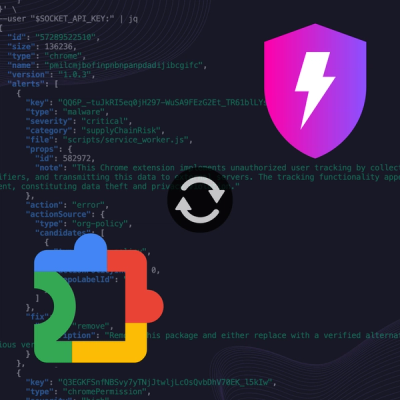
Product
Socket Now Protects the Chrome Extension Ecosystem
Socket is launching experimental protection for Chrome extensions, scanning for malware and risky permissions to prevent silent supply chain attacks.
github.com/RossoDiablo/html_link_parser
In this exercise your goal is create a package that makes it easy to parse an HTML file and extract all of the links (<a href="">...</a> tags). For each extracted link you should return a data structure that includes both the href, as well as the text inside the link. Any HTML inside of the link can be stripped out, along with any extra whitespace including newlines, back-to-back spaces, etc.
Links will be nested in different HTML elements, and it is very possible that you will have to deal with HTML similar to code below.
<a href="/dog">
<span>Something in a span</span>
Text not in a span
<b>Bold text!</b>
</a>
In situations like these we want to get output that looks roughly like:
Link{
Href: "/dog",
Text: "Something in a span Text not in a span Bold text!",
}
Once you have a working program, try to write some tests for it to practice using the testing package in go.
1. Use the x/net/html package
I recommend checking out the x/net/html package for this task, which you will need to go get. It is provided by the Go team, but isn't included in the standard library. This makes it a little easier to parse HTML files.
2. Ignore nested links
You can ignore any links nested inside of another link. Eg with following HTML:
<a href="#">
Something here <a href="/dog">nested dog link</a>
</a>
It is okay if your code returns only the outside link.
3. Get something working before focusing on edge-cases
Don't worry about having perfect code. Chances are there will be a lot of edge cases here that will be kinda tricky to handle. Just try to cover the most basic use cases first and then improve on that.
4. A few HTML examples have been provided
I created a few simpler HTML files and included them in this repo to help with testing. They won't cover all potential use cases, but should help you start testing out your code.
5. The fourth example will help you remove comments from your link text
Chances are your first version will include the text from comments inside a link tag. Mine did. Use ex4.html to test that case out and fix the bug.
Hint: See NodeType constants and look for the types that you can ignore.
In the solution for this exercise I end up using a DFS, which is a graph theory algorithm. If you want to learn a little more about that, I have discussed it on YouTube here - https://www.youtube.com/watch?v=zboCGDMnU3I
There is a complete series on algorithms and graph theory, though at this time it is somewhat incomplete. I never have enough time in the day 🙁. Hopefully one day Let's Learn Algorithms will be its own series like Gophercises.
The only bonuses here are to improve your tests and edge-case coverage.
FAQs
Unknown package
Did you know?

Socket for GitHub automatically highlights issues in each pull request and monitors the health of all your open source dependencies. Discover the contents of your packages and block harmful activity before you install or update your dependencies.

Product
Socket is launching experimental protection for Chrome extensions, scanning for malware and risky permissions to prevent silent supply chain attacks.

Product
Add secure dependency scanning to Claude Desktop with Socket MCP, a one-click extension that keeps your coding conversations safe from malicious packages.

Product
Socket now supports Scala and Kotlin, bringing AI-powered threat detection to JVM projects with easy manifest generation and fast, accurate scans.